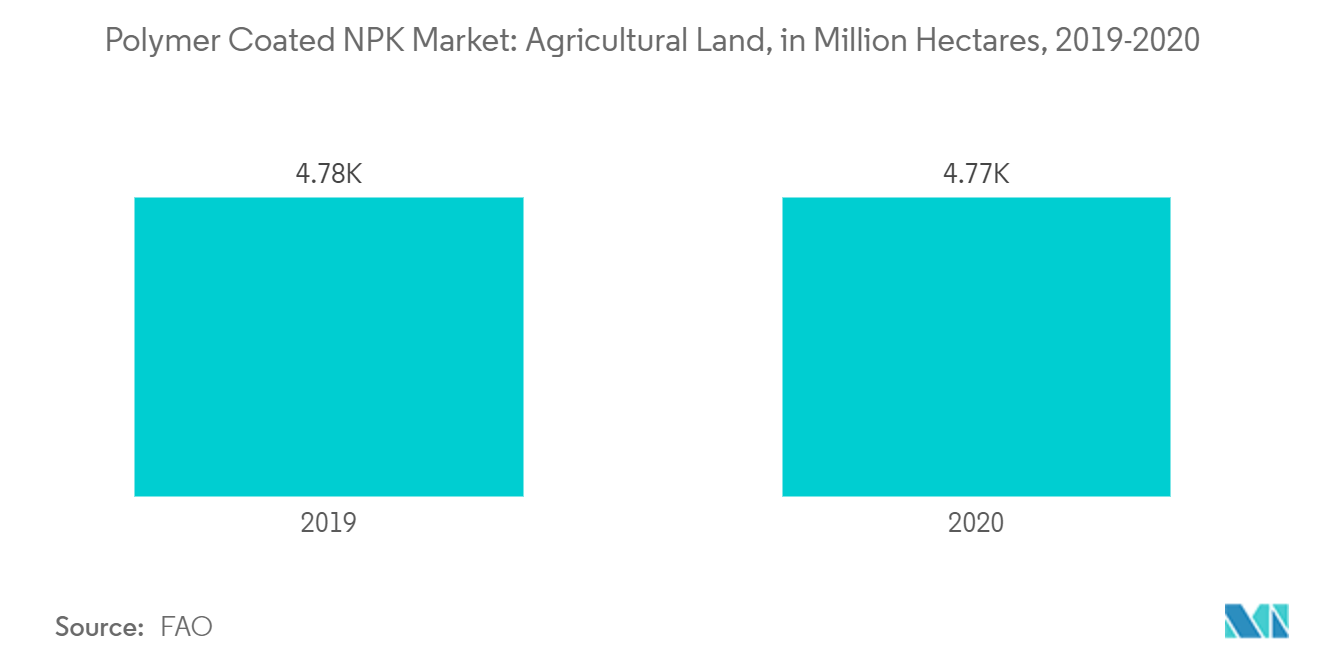Market Trends of Polymer Coated NPK Industry
Declining Agricultural Land and The Need For Increased Crop Productivity
Globally, the percentage of agricultural land has been decreasing continually over the past decade. For instance, according to World Bank, the share of agricultural land decreased from 1,389,750 thousand hectares in 2018 to 1,387,172 by 2020. It is projected to decrease further in the coming years. With this decline in agricultural land, coupled with the increasing food demand worldwide, the usage of effective fertilizers such as polymer-coated fertilizers is projected to increase globally. This, in turn, is leading to the growth of the market studied.
Moreover, due to the increasing incomes and urbanization, the people in the country are willing to spend more on the maintenance of turf grasses in the lawns. According to a study by the Bureau of labor statistics, in 2020, the annual spending on the maintenance of lawns increased from USD 113.61 in 2018 to USD 115.07. Thus, with increasing spending and rising environmental conscience, adopting biodegradable controlled-release fertilizers is anticipated to grow in the coming years.
The increasing usage of mineral fertilizers led to the over-accumulation of fertilizers in the soil. Empirical studies have proven that biodegradable polymer coatings are helpful in the controlled release of nutrients into the soil while reducing nutrient losses, such as ammonia volatilization, and conserving soil fertility in the long run.
Furthermore, food security has become an increasing concern. Countries like the United States, Brazil, Japan, China, etc., are focusing on increasing the self-sufficiency ratio by increasing domestic production to meet the demand for both traditional Japanese and western food types. This increasing demand for food drives the market growth.

North America Dominates the Market
North America occupied the largest share of the market for polymer-coated NPK fertilizers, with the United States contributing to the largest share in the region. According to 'International Fertilizer Industry Association', over the last decade, field experiments and trial projects related to polymer fertilizers in agriculture crops have increased the demand, primarily from citrus fruit, strawberry, vegetables, and nut growers.
Furthermore, the government is promoting the use of sustainable fertilizers in the country. The US Environmental Protection Agency adopted the Nutrient Reduction Memorandum, in which the agency works with the US Department of Agriculture to reduce excess fertilizer usage and increase efficiency. Attributed to its benefits in fighting nitrogen leaching and nutrient pollution, the Candian government is also promoting the use of enhanced fertilizers. For instance, in September 2022, the government added polymer-coated urea to the list of enhanced efficiency fertilizer products approved for reimbursement from its On-Farm Climate Action Fund (OFCAF) in Canada. Furthermore, farmers get financial support for implementing nitrogen fertilizer management practices under the OFCAF initiative in the country.
The ongoing research on sugarcane cultivation research reveals that the net return from controlled-released fertilizers for sugarcane is USD 2,839.0 per hectare, whereas, for traditional NPK fertilizers, it is USD 2,173.0 per hectare. Several companies, like Agrium and Koch Agronomic Services, provide advanced polymer coating technology for a consistent release of NPK fertilizers for commercial products in the region. The controlled-release technology through polymer coating provides fruits with efficient and consistent consumption of NPK fertilizer. This, in turn, improves the quality of the fruits and fewer fruit drops, thereby, driving the demand for the same in the future.


